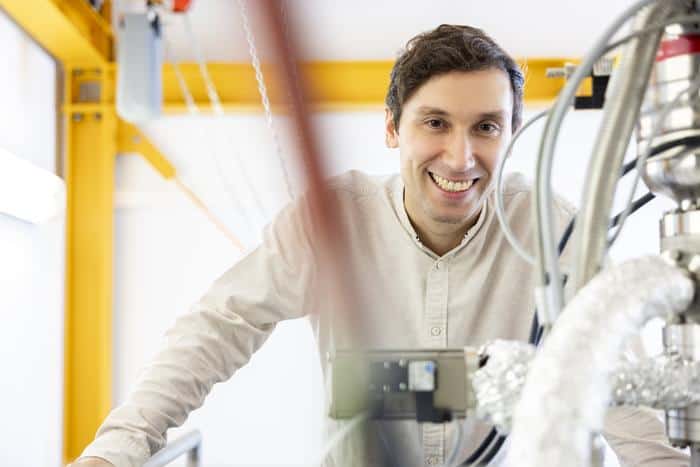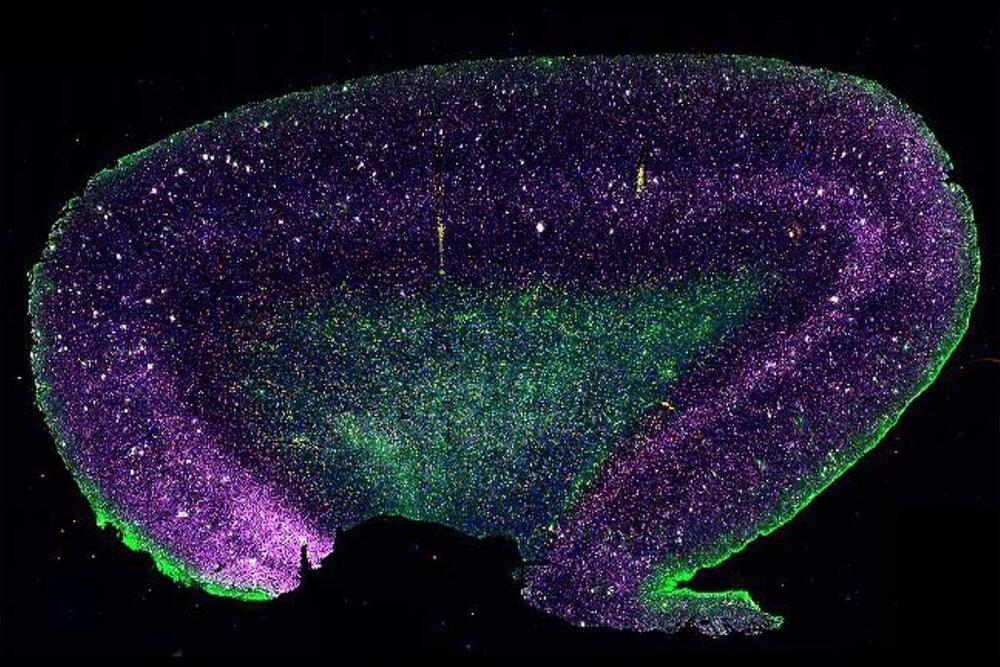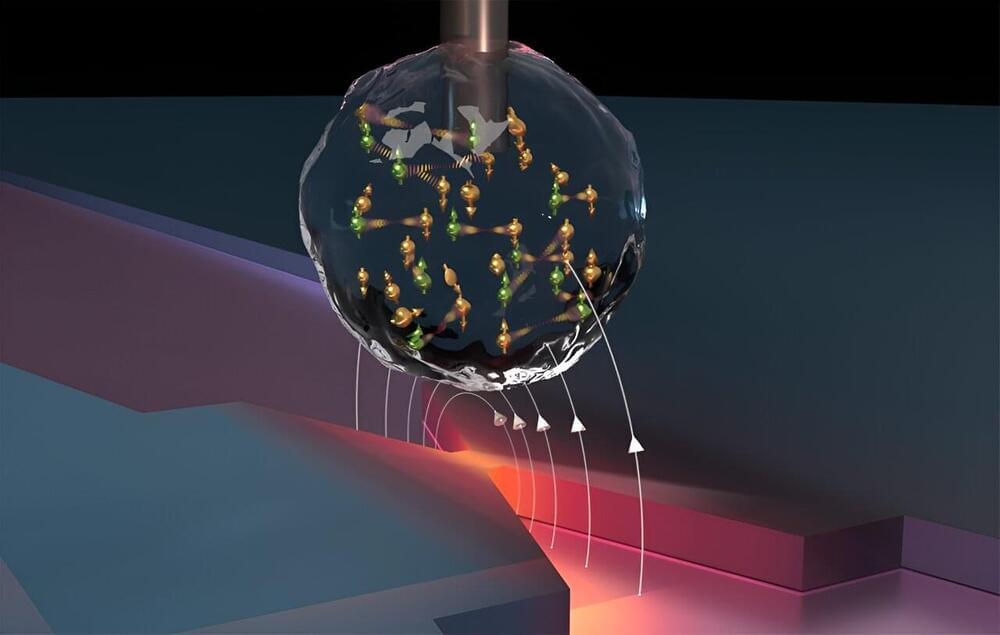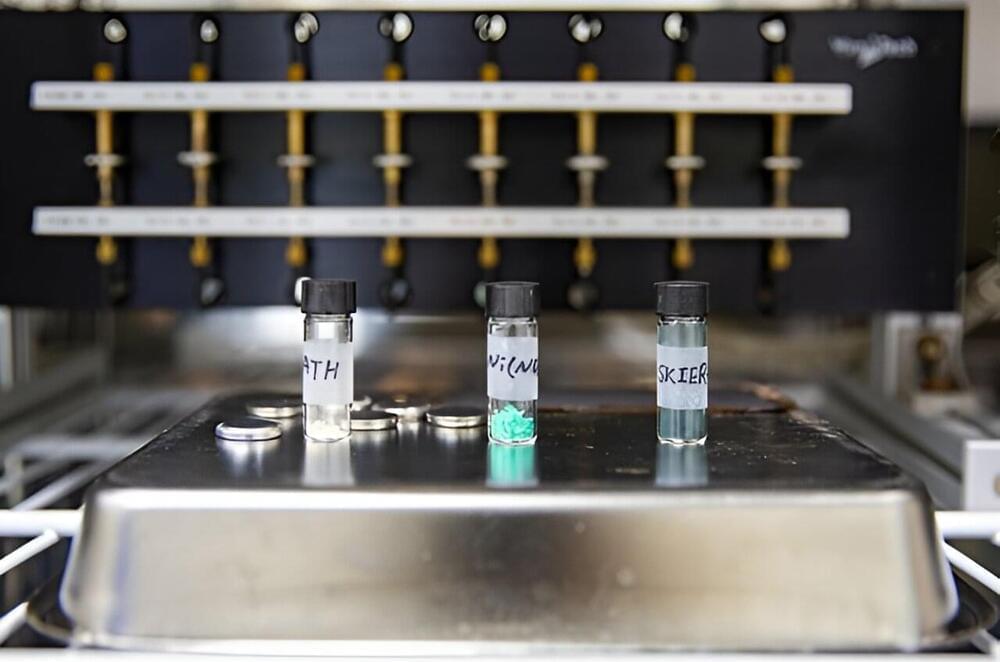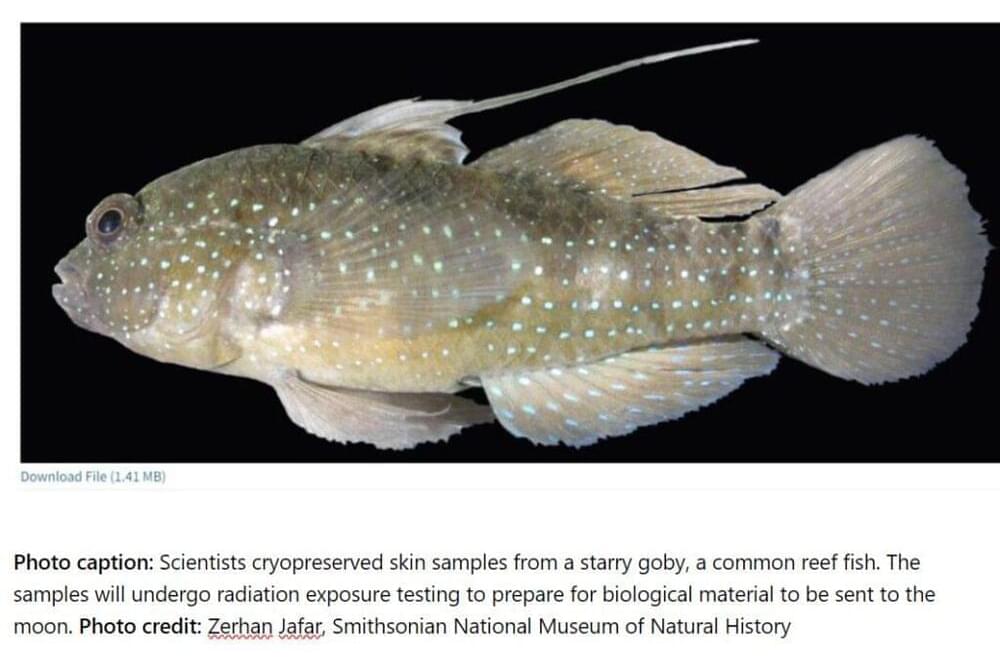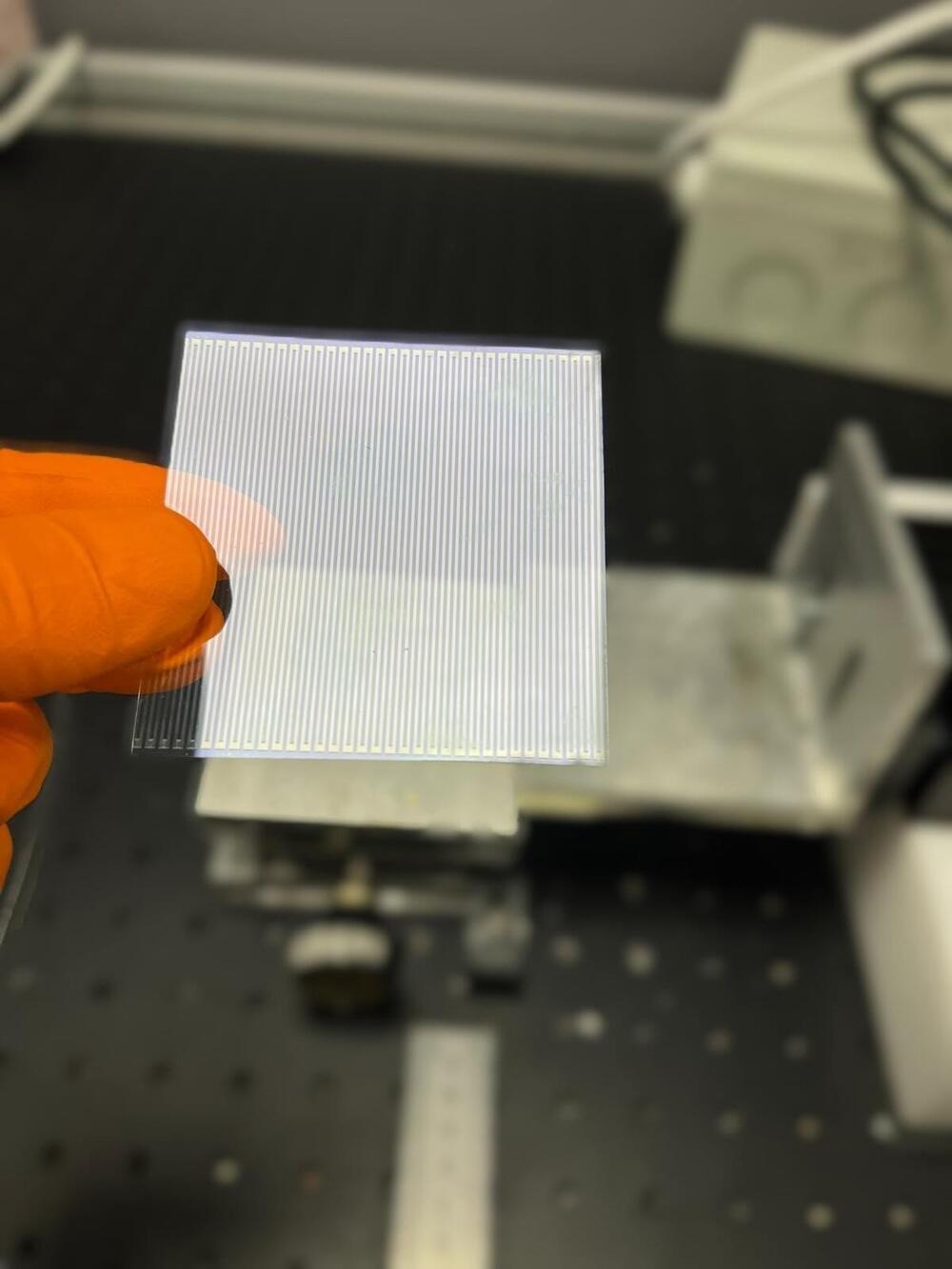Page 9
Aug 23, 2024
Quantum sensor detects magnetic and electric fields from a single atom
Posted by Genevieve Klien in categories: particle physics, quantum physics
The next step, says Esat, is to increase the new device’s magnetic field sensitivity by implementing more advanced sensing protocols based on pulsed electron spin resonance schemes and by finding molecules with longer spin decoherence times. “We hope to increase the sensitivity by a factor of about 1,000, which would allow us to detect nuclear spins at the atomic scale,” he says.
A holy grail for quantum sensing
The new atomic-scale quantum magnetic field sensor should also make it possible to resolve spins in certain emerging two-dimensional quantum materials. These materials are predicted to have many complex magnetic orders, but they cannot be measured with existing instruments, Heinrich and his QNS colleague Yujeong Bae note. Another possibility would be to use the sensor to study so-called encapsulated spin systems such as endohedral-fullerenes, which comprise a magnetic core surrounded by an inert carbon cage.
Aug 23, 2024
First American sodium-ion battery factory will make cells with lifespan of 50,000 cycles that charge in 10 minutes
Posted by Genevieve Klien in categories: chemistry, energy, sustainability, transportation
Built by Natron Energy, the Edgecombe County facility is planned for 24 GWh of annual capacity, which would turn Natron from a startup into the first sodium-ion battery production juggernaut on US soil.
Sodium-ion batteries are cheaper, safer, with much longer lifespan and faster charging than conventional Li-ion packs.
Chinese companies are already using them in grid-level energy storage systems of local utilities, to balance their renewable energy mix. Some sodium-ion battery packs are even making their way into electric vehicles there, even though the chemistry offers lower energy density than Li-ion batteries.
Aug 23, 2024
AWS exec explains how AI agents are driving a radical shift in the world of coding
Posted by Mike Diverde in category: robotics/AI

In an era where AI is reshaping industries at breakneck speed, Doug Seven finds himself at the forefront of a technology that’s changing the way developers approach their work.
As the director and general manager of AWS AI Developer Experiences, Seven is at the helm of this transformation, where specialized AI is not just assisting but actively reshaping how code is written and deployed.
Aug 23, 2024
Scientists Identify New Class of Semiconductor Nanocrystals
Posted by Natalie Chan in categories: chemistry, computing
U.S. Naval Research Laboratory (NRL) scientists confirm the identification of a new class of semiconductor nanocrystals with bright ground-state excitons, a significant advancement in the field of optoelectronics, in an article published in the American Chemical Society (ACS) journal ACS Nano.
The groundbreaking theoretical research could revolutionize the development of highly efficient light-emitting devices and other technologies.
Generally, the lowest-energy exciton in nanocrystals is poorly emitting, earning the name “dark” exciton. Because it slows the emission of light, the dark exciton limits the performance of nanocrystal-based devices like lasers or light-emitting diodes (LEDs). Scientists have long sought to overcome the dark exciton.
Aug 23, 2024
The Shape of the Brain: Spatial Biology of Alzheimer’s Disease
Posted by Dan Breeden in categories: biotech/medical, neuroscience
Using #CellDIVE multiplexed imaging and antibodies from Cell Signaling Technology to uncover cell identity and brain structure in Alzheimer’s disease, demonstrating how spatial biology can lead to advances in therapy development for neuro degeneration.
🖼️: Adult Human Alzheimer’s brain demonstrating a panel of 15 markers.
Uncover cell identity and brain structure in Alzheimer’s disease with Cell DIVE multiplexed imaging, demonstrating how spatial biology can lead to advances in therapy development for neurodegeneration.
Continue reading “The Shape of the Brain: Spatial Biology of Alzheimer’s Disease” »
Aug 23, 2024
Advancing nanoscale imaging capabilities with dynamic nuclear polarization
Posted by Paul Battista in categories: materials, nanotechnology
Dynamic nuclear polarization (DNP) has revolutionized the field of nanoscale nuclear magnetic resonance (NMR), making it possible to study a wider range of materials, biomolecules and complex dynamic processes such as how proteins fold and change shape inside a cell.
Aug 23, 2024
Redox-active metal-organic framework developed for Li batteries in freezing conditions
Posted by Shailesh Prasad in categories: drones, sustainability
The Korea Institute of Energy Research (KIER) has developed a redox-active metal-organic hybrid electrode material (SKIER-5) for Li batteries that remains stable in cold conditions as low as minus 20 degrees Celsius. By addressing the limitations of graphite as an anode material of conventional Li batteries under freezing conditions, SKIER-5 has the potential to be a superior alternative. This novel material can be used in Li batteries for a variety of applications, including electric vehicles, drones, and ultra-small electronic devices, even at low temperatures.
Currently, graphite is the conventional material used for anodes in lithium-ion batteries due to its thermodynamic stability and low cost. However, batteries with graphite anodes have significant drawbacks: their storage capacity sharply decreases at subzero temperatures, and dendrites can form on the anode surface during charging. This can lead to thermal runaway and potential explosions.
A research team led by Dr. Jungjoon Yoo, Dr. Kanghoon Yim, and Dr. Hyunuk Kim at KIER has developed a redox-active conductive metal-organic framework called “SKIER-5.” This framework is assembled from a trianthrene-based organic ligand and nickel ions. SKIER-5 exhibited a discharge capacity five times higher than that of graphite in subzero environments.
Aug 23, 2024
Scientists devise Method to Secure Earth’s Biodiversity on the Moon
Posted by Natalie Chan in categories: biotech/medical, cryonics, education, genetics, governance, life extension
Proposed lunar biorepository could store genetic samples without electricity or liquid nitrogen. New research led by scientists at the Smithsonian proposes a plan to safeguard Earth’s imperiled biodiversity by cryogenically preserving biological material on the moon. The moon’s permanently shadowed craters are cold enough for cryogenic preservation without the need for electricity or liquid nitrogen, according to the researchers.
The paper, published today in BioScience and written in collaboration with researchers from the Smithsonian’s National Zoo and Conservation Biology Institute (NZCBI), Smithsonian’s National Museum of Natural History, Smithsonian’s National Air and Space Museum and others, outlines a roadmap to create a lunar biorepository, including ideas for governance, the types of biological material to be stored and a plan for experiments to understand and address challenges such as radiation and microgravity. The study also demonstrates the successful cryopreservation of skin samples from a fish, which are now stored at the National Museum of Natural History.
“Initially, a lunar biorepository would target the most at-risk species on Earth today, but our ultimate goal would be to cryopreserve most species on Earth,” said Mary Hagedorn, a research cryobiologist at NZCBI and lead author of the paper. “We hope that by sharing our vision, our group can find additional partners to expand the conversation, discuss threats and opportunities and conduct the necessary research and testing to make this biorepository a reality.”
Aug 23, 2024
Flexible nanogenerator with enhanced power density could one day rival the power of solar panels
Posted by Shailesh Prasad in categories: nanotechnology, solar power, sustainability, wearables
Your early morning run could soon help harvest enough electricity to power your wearable devices, thanks to a new nanotechnology developed at the University of Surrey.
Surrey’s Advanced Technology Institute (ATI) has developed highly energy-efficient, flexible nanogenerators, which demonstrate a 140-fold increase in power density when compared to conventional nanogenerators. ATI researchers believe that this development could pave the way for nano-devices that are as efficient as today’s solar cells.
The findings are published in the journal Nano Energy.

